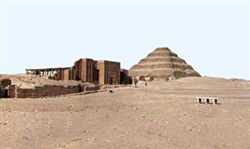
The modern name for the most important cemetery of the residence Memphis, situated roughly 16 kilometers south of Giza. It has been suggested that the name is derived from the name of the funerary god Sokar. There are tombs here from every period in Egyptian history, from the 1st Dynasty down to the end of the Pharaonic period and also from the Coptic period. In addition to a number of Old Kingdom royal pyramids and the mastaba tombs of officials from those reigns, there are also the tombs of many important people from later centuries, including the period when Thebes was the religious centre of Egypt. After all, Memphis was the residence throughout most of Egypt's history and the vast administrative machinery was located there. Further, the underground galleries of the Serapeum are to be found at Saqqara, intended for the burials of the Apis bulls, as well as other animal galleries for baboons, ibises, hawks, cats, dogs, jackals and other animals. The most famous of the pyramids is that of Djoser from the 3rd Dynasty. It is the first real pyramid, built by his architect Imhotep. The construction is also known as the Step Pyramid. From a history of religions point of view, the pyramid of Unas is also important because it was the first to have Pyramid Texts inscribed on the walls of its chambers. During the last decades many tombs of high officials have been (re)discovered in Saqqara. Among them is the tomb of Horemheb from the time that he was still a general under Tutankhamun. Later, when he became king, he built a new tomb for himself in the Valley of the Kings.